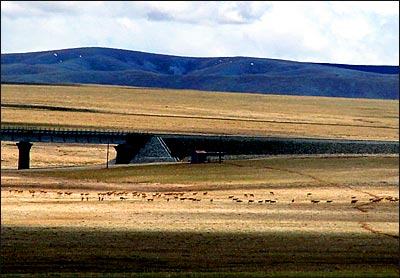| Home / Environment / Photo News | Tools: Save | Print | E-mail | Most Read |
| Tibetan Antelopes Unfazed by Railway |
| Adjust font size: |
An investigation conducted by the Hoh Xil Nature Reserve Administration showed that the Qinghai-Tibet Railway, which began operation on July 1 last year, has not interrupted the migration of Tibetan antelopes or altered their behavior, Xinhua News Agency reported on March 19.
Cega, the director of the state-level nature reserve, told a reporter from Xinhua that Tibetan antelopes have become completely accustomed to the animal passages built along the Qinghai-Tibet railway line and their previous migratory routes remain unchanged. During the lambing season, crowds of female antelopes passed through the Teams monitoring their behavior for the conservation stations in Budongquan, Suonan Dajie, Wudaoliangzi have found that Tibetan antelopes are no longer frightened at the sight of human beings and vehicles. Gradually, they have grown accustomed to the high-speed trains and more antelopes are now living beside the railway line. The 1,142-km Golmud-Lhasa section of the railway is totally sealed by guardrails to guarantee the safety of antelopes and other wild animals. In addition, a total of 33 wildlife passages were built along the railway line to facilitate the movement of wild animals while migrating and seeking food. Cega added that anti-poaching efforts have been a great success, with the number of Tibetan antelopes increasing steadily.
(China.org.cn by Zhang Tingting, March 21, 2007) |
| Tools: Save | Print | E-mail | Most Read |
 |
| Related Stories |

